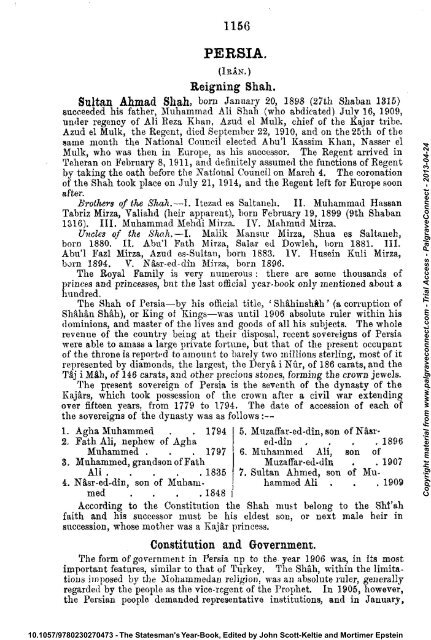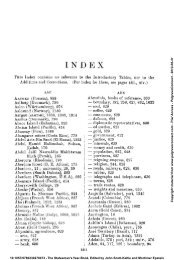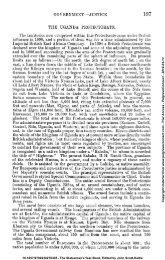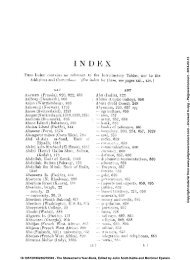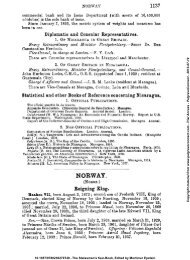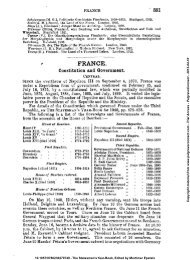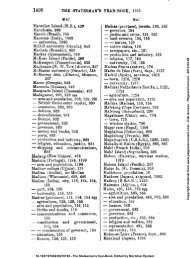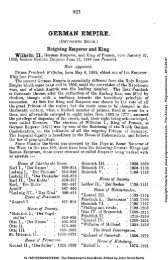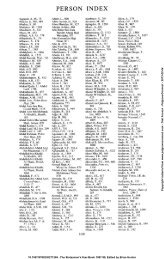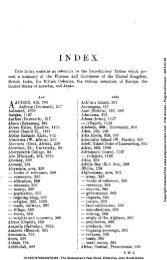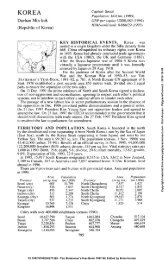PERSIA. - Palgrave Connect
PERSIA. - Palgrave Connect
PERSIA. - Palgrave Connect
Create successful ePaper yourself
Turn your PDF publications into a flip-book with our unique Google optimized e-Paper software.
1156<br />
<strong>PERSIA</strong>.<br />
(IRAN.)<br />
Reigning Shah.<br />
Sultan Ahmad Shah, born January 20, 1898 (27th Shaban 1315)<br />
succeeded his father, Muhammad Ali Shan (who abdicated) July 16, 1909,<br />
under regency of Ali Eeza Khan, Azud el Mulk, chief of the Kajar tribe.<br />
Azud el Mulk, the Regent, died September 22, 1910, and on the 25th of the<br />
same month the National Council elected Abu'l Kassim Khan, Nasser el<br />
Mulk, who was then in Europe, as his successor. The Regent arrived in<br />
Teheran on February 8, 1911, and definitely assumed the functions of Regent<br />
by taking the oath before the National Council on March 4. The coronation<br />
of the Shah took place on July 21, 1914, and the Regent left for Europe soon<br />
after.<br />
Brothers of the Shah.—I. Itezad es Saltaneh. II. Muhammad Hassan<br />
Tabriz Mirza, Valiahd (heir apparent), born February 19, 1899 (9th Shaban<br />
1316). III. Muhammad Mehdi Mirza. IV. Mahmud Mirza.<br />
Uncles of the Shah.—I. Malik Mansur Mirza, Shua es Saltaneh,<br />
born 1880. II. Abu'l Fath Mirza, Salar ed Dowleh, horn 1881. III.<br />
Abu'l Fazl Mirza, Azud es-Sultau, born 1883. IV. Husein Kuli Mirza,<br />
born 1894. V. Nasr-ed-din Mirza, born 1896.<br />
The Royal Family is very numerous : there are some thousands of<br />
princes and princesses, but the last official year-book only mentioned about a<br />
hundred.<br />
The Shah of Persia—by his official title, ' Shahinsh&h' (a corruption of<br />
Shahan Shah), or King of Kings—was until 1906 absolute ruler within his<br />
dominions, and master of the lives and goods of all his subjects. The whole<br />
revenue of the country being at their disposal, recent sovereigns of Persia<br />
were able to amass a large private fortune, but that of the present occupant<br />
of the throne is reported to amount to barely two millions sterling, most of it<br />
represented by diamonds, the largest, the Derya i Nur, of 186 carats, and the<br />
Taj i Mali, of 146 carats, and other precious stones, forming the crown jewels.<br />
The present sovereign of Persia is the seventh of the dynasty of the<br />
Kajars, which took possession of the crown after a civil war extending<br />
over fifteen years, from 1779 to 1794. The date of accession of each of<br />
the sovereigns of the dynasty was as follows :—<br />
1. Agha Muhammed . . 1794 5. Muzaffar-ed-din, son of Nasr-<br />
2. Fath Ali, nephew of Agha ed-din . . . . 1896<br />
Muhammed . . . 1797 6. Muhammed Ali, son of<br />
3. Muhammed, grandson of Fath Muzaffar-ed-din . .1907<br />
Ali 1835 7. Sultan Ahmed, son of Mu-<br />
4. Nasr-ed-din, son of Muham- hammed Ali . . . 1909<br />
med . . . . 1848 ]<br />
According to the Constitution the Shah must belong to the Shl'ah<br />
faith and his successor must be his eldest son, or next male heir in<br />
succession, whose mother was a Kajar princess.<br />
Constitution and Government.<br />
The form of government in Persia up to the year 1906 was, in its most<br />
important features, similar to that of Turkey. The Shah, within the limitations<br />
imposed by the Mohammedan religion, was an absolute ruler, generally<br />
regarded by the people as the vice-regent of the Prophet. In 1905, however,<br />
the Persian people demanded representative institutions, and in January,<br />
10.1057/9780230270473 - The Statesman's Year-Book, Edited by John Scott-Keltie and Mortimer Epstein<br />
Copyright material from www.palgraveconnect.com - Trial Access - <strong>Palgrave</strong><strong>Connect</strong> - 2013-04-24
CONSTITUTION AND GOVERNMENT 1157<br />
1906, the Government announced that the Shah had given his consent to<br />
the establishment of a National Council (Mejlia i Shora i Milli). But the<br />
Mejlis was never properly constituted, though attempts were male to set it<br />
working. Since November, 1915, it has ceased to exist as a legislative or<br />
administrative body. (For a history of the struggle see THE STATESMAN'S<br />
YKAR-BOOK for 1916, p. 1220.) The government of the country is in the<br />
hands of the Cabinet, which was formed on February 27, 1918, as follows :—<br />
Prime Minister and Minister of the. Interior —Mostowfiol-Mamalek.<br />
Minister for Foreign Affairs.—Moshaverol-Mamalek.<br />
Minister of War.—Moshirod-Dowleh.<br />
Minister of Education.—Motamenol-Molk.<br />
Minister of Finance.—Mokhberol-Molk.<br />
Minister of Public Works.—Moi'uol-Vezareh<br />
Minister of Justice.—Mokhberos-Saltaneh.<br />
Minister of Posts and Telegraphs.—Sardar-Assad.<br />
The country is divided into thirty-three provinces, which are governed<br />
by governors-general, who are directly responsible to the central Government,<br />
and can nominate the lieutenant-governors of the districts comprised<br />
in their own governments-general. Some of the governments-general<br />
are very small, and do not bear subdivision into districts, &c. ; others are very<br />
large, and comprise several provinces. Governors-general and lieutenantgovernors<br />
are generally called Hakim, the former also often have the title<br />
of Wali, Ferman Ferma, &c. A lieutenant-governor is sometimes called<br />
Naib el-Hukumah ; one of a small district is a Zabit. Every town has a<br />
mayor or chief magistrate called Kalautar, or Darogha, or Beglerbegi.<br />
Every quarter of a town or parish, and every village, has a chief who is<br />
called Kedkhoda. These officers, whose chief duty is the collection of the<br />
revenue, are generally appointed by the lieutenant-governors, but sometimes<br />
elected by the citizens. Most of the governors have a vizir or a plshkar, a<br />
man of experience, to whom are entrusted the accounts and the details of the<br />
government. The chiefs of nomad tribes are called Ilkhani, Ilbegi, Wali,<br />
Serdar, Sheikh, Tushmal; they are responsible for the collection of the<br />
revenues to the governors of the province in which their tribe resides.<br />
A law of May, 1907, provides for the election of rural and town councils.<br />
In these elections practically all subjects have a right to vote, and the<br />
councils will be in direct communication with the National Council.<br />
On August 31, 1907, Great Britain and Russia agreed between themselves to limit the<br />
spheres of their respective interests in Persia to the Persian provinces adjoining the<br />
Russian frontier on tlte one hand, and the British frontier on the other. The two Powers<br />
were to respect the integrity and independence of Persia, but, at the same time, contemplated<br />
the possible necessity of ilnancia] control in conformity with the principles of<br />
the agreement. The approxiviate area, population, and customs revenue of each of the<br />
three spheres are given as follows :—<br />
British sphere . . .<br />
Russian sphere<br />
-<br />
Area<br />
sq. miles<br />
137,000<br />
305,000<br />
188,000<br />
Population<br />
690,000<br />
6,900,000<br />
1,910.000<br />
Revenue<br />
Customs<br />
(1915-16)<br />
£<br />
46,740<br />
204.800<br />
160.000<br />
The Anglo-Knssian Agreement of 1907 wns formally denounced hy the Bolshevik<br />
Russian Government on January 30, 1918, while the British Government have informed<br />
t'.o Persian Government that for the present the agreement is to he regarded as in<br />
abeyance On May 2, 191S, the Persian Government announced that it regarded the<br />
agreement as null and void.<br />
10.1057/9780230270473 - The Statesman's Year-Book, Edited by John Scott-Keltie and Mortimer Epstein<br />
Copyright material from www.palgraveconnect.com - Trial Access - <strong>Palgrave</strong><strong>Connect</strong> - 2013-04-24
1158 <strong>PERSIA</strong><br />
Area and Population.<br />
According to the latest and most trustworthy estimates, the country—<br />
extending for about 700 miles from north to south, and for 900 miles<br />
from east to west—contains an area of 628,000 square miles. A vast<br />
portion of this area is an absolute desert, and the population is everywhere<br />
so scanty as not to exceed, on the average, fifteen inhabitants to the<br />
square mile.<br />
The population now is estimated at about 9J millions.<br />
The number of Europeans residing in Persia does not exceed 1,200.<br />
There are about 600 British subjects resident in Persia (exclusive of British<br />
Indians).<br />
The principal cities of Persia are:—Teheran, with 280,000; Tabriz,<br />
with 200,000; Ispahan, with 80,000; Meshed and Kerman, with 60,000;<br />
Yezd, with 45,000 ; Barfurush and Shiraz, with 50 000 ; Hamadan, Kazvin,<br />
Kom, Kashan, Resht, each with 30,000 to 40.000 inhabitants. Of the<br />
nomads 260,000 are Arabs, 720,000 Turks, 675,000 Kurds and Leks, 20,700<br />
Baluchis and Gipsies, 234,000 Lurs.<br />
Religion.<br />
Of the population about 8| millions are Mahometans of the Shi'ah sect,<br />
and 850,000 of the Sunni s^ct ; 10,000 are Parsis (Guebres), 40,000 Jews,<br />
50,000 Armenians, and 30,000 Nestorians.<br />
The Mahometans of the sect called Shi'ah differ to some extent in<br />
religious doctrine, and more in historical belief, from the Moslems of the<br />
Turkish Empire, who are called Sunni. The Persian priesthood (ulema) is<br />
very powerful, and works steadily against all progress coming from Europe.<br />
Any person capable of reading the Koran and interpreting its laws may act<br />
as a priest (mulla). As soon as such a priest becomes known for his just<br />
interpretation of the divine law, and for his knowledge of the traditions<br />
and articles of faith, he is called a mujtahid, or chief priest. There are<br />
many mujtahids in Persia, sometimes several in one town; there are,<br />
however, only four or five whose decisions are accepted as final. The highest<br />
authority, the chief priest of all, is the mujtahid, who resides at Kerbela,<br />
near Baghdad, and some consider him the vicegerent of the Prophet, the<br />
representative of the Imam. The Shah and the Government have no voice<br />
in the matter of appointing the mujtahids, but the Sheikh-ul-Islam, chief<br />
judge, and the Imam-i-Jum'ah, chief of the great mosque (Masjed-i-Jam'ah)<br />
of a city, are appointed by Government. Under the Imam-i-Jum'ah are the<br />
pish namaz or khatib (leader of public prayers and reader of the Khutbeh,<br />
the Friday oration), the mu'azzin (crier for prayers), and sometimes the<br />
mutavali (guardian of the mosque); this latter, as well as the mu'azzin,<br />
need not necessarily be a priest. All mosques and shrines have some endowments<br />
(wakf), and out of the proceeds of these are provided the funds for the<br />
salaries of the priests attached to them. The shrines of some favourite saints<br />
are so richly endowed as to be able to keep an immense staff of priests,<br />
servants, and hangers-on.<br />
The Gregorian National Armenians form two dioceses, each under a<br />
bishop. One bishop resides at Tabriz, the other at Ispahan. There are also<br />
a few thousand Roman Catholic Armenians in Persia who have a bishop of<br />
their own rite at Ispahan, the bishop of the Latin rite residing at Urumiah.<br />
There is a wide tolerance exercised towards Armenians and Nestorians, Jews,<br />
and Parsis in cities where Europeans reside ; in other places, however, they<br />
occasionally suffer oppression from Mussulmans belonging to the lower<br />
classes.<br />
10.1057/9780230270473 - The Statesman's Year-Book, Edited by John Scott-Keltie and Mortimer Epstein<br />
Copyright material from www.palgraveconnect.com - Trial Access - <strong>Palgrave</strong><strong>Connect</strong> - 2013-04-24
INSTRUCTION—J USTICE—FINANCE 1159<br />
Instruction.<br />
In recent years the educational question has played a prominent part in<br />
Persia. Many schools of various degrees, entirely on European lines, hare<br />
been established ; the Ministry of Education has undergone radical reforms ;<br />
the Educational Council recently created is doing very useful work ; female<br />
education has been greatly advanced. It is said that there are now some 180<br />
schools in Persia with an aggregate of 10.000 pupils of both sexes.<br />
There are many colleges (medresseh), supported by public funds, in which<br />
students are instructed in religion and Persian and Arabic literature, as well<br />
as in a certain amount of scientific knowledge, and many schools for children,<br />
while private tutors are very common, being employed by all families who<br />
have the means. A polytechnic school with a number of European professors,<br />
opened in Teheran in 1849, has done much towards introducing the knowledge<br />
of Western languages and science into Persia. There are also military colleges<br />
at Teheran and Tabriz. At Teheran there is a French school supported by<br />
the Alliance Francaise. But the bulk of the population are taught only to<br />
read the Koran. A 'political college,' Medresseh i Siasi, now having 30<br />
pupils, was opened in 1900, and prepares candidates for service in the Foreign<br />
Office, which pays 75,000 kran per annum for its maintenance.<br />
Justice.<br />
Justice is administered by the governors and their representatives, and by<br />
the Sheikhs-ul-Islam and the priesthood. The former administer justice<br />
according to the Urf, the unwritten or common law ; the latter according to<br />
the Shar', the written or divine law.<br />
The dispensation of justice is always summary. In May, 1888, the Shah<br />
published a proclamation stating that henceforth no subject would be punished<br />
except by operation of law, and that all subjects had full liberty as to life<br />
and property. But another proclamation published in June annulled the first<br />
as far as regards liberty of property.<br />
Finance.<br />
A Commission, composed of the Administrator of the Customs (a Belgian),<br />
one Russian and one Englishman inspects and approves the past due claims<br />
on the Government.<br />
The revenue for 1911-12 amounted to 2,042,8502 , and the expenditure<br />
to 1,608,6002. In 1912-13 the revenue amounted to 1,055,7922., and in<br />
1913-14 to 1,480,7782. These are the latest available figures.<br />
More than half of the revenue consists of payments in cash or kind<br />
raised by assessments upon towns, villages, and districts, each of which has<br />
to contribute a fixed sum, the amount of which is changed from time to time by<br />
tax-assessors (mumayii;) appointed by the Government. Almost the entire<br />
burthen of taxation lies upon the labouring classes.<br />
Approximate gross Customs receipts for three years (£1 =60 Kran):—<br />
-<br />
Northern Zone:—<br />
Azerbaijan (Tabriz) . . . .<br />
Ghilan (Enzeli) . . . .<br />
Kermanshah and Hamadan .<br />
1913-14<br />
£<br />
171,725<br />
40.S22<br />
184,410<br />
47,0S3<br />
27,786<br />
91,769<br />
04,663.<br />
1914-15<br />
£<br />
S5,912<br />
36,809<br />
128,333<br />
26,018<br />
17,700<br />
64,000<br />
^ W «•<br />
1915-16<br />
£<br />
22,109<br />
46,917<br />
106,970<br />
15,550<br />
7,134<br />
50,867<br />
14,380<br />
10.1057/9780230270473 - The Statesman's Year-Book, Edited by John Scott-Keltie and Mortimer Epstein<br />
Copyright material from www.palgraveconnect.com - Trial Access - <strong>Palgrave</strong><strong>Connect</strong> - 2013-04-24
1160 <strong>PERSIA</strong><br />
Southern Zone :—<br />
Total<br />
-<br />
1913-14<br />
£<br />
82,021<br />
38,fc97<br />
53,110<br />
19,580<br />
861,8721<br />
1914-15<br />
£<br />
90,975<br />
26,378<br />
32,310<br />
28,425<br />
589,197<br />
1915-16<br />
£<br />
115,142<br />
40,547<br />
61,123<br />
10,896<br />
491,635<br />
1 The Kran value of the gross receipts is actually 4,276,S3S hetler than the previous<br />
year, hut the 10% rise in the rate of exchange reduces it to nil in the sterling value.<br />
"With all overdue instalments paid up, the total debt of Persia as at<br />
December 31, 1917, was as follows :—<br />
Loans<br />
1. Russian 5 per cent, loan of 1900, 1902 (Roubles)<br />
2. Russian Consolidated 7 per cent, loan, 1911 (Krans)<br />
4 Imperial Bank of Persia 5 p< r cent, loan . (£)<br />
5. Britisli Advances of 1912-14, 7 per cent , (£)<br />
G. Russian Advances (Roubles)<br />
7. British Advances, 1915-17 , . . . ( £ )<br />
8. Ditto . . . (Krans)<br />
Original<br />
Amount<br />
32,500,000<br />
60.000,030<br />
314J281 13 4<br />
1,250,000 0 0<br />
490,000 0 0<br />
1,891,500<br />
817,000 9 0<br />
1,000,000<br />
Outstanding<br />
31,429,500<br />
30,454,394<br />
238,310 13 5<br />
1,237,187 10 0<br />
490,000 0 0<br />
1,576,250<br />
817,000 0 0<br />
1,000,000<br />
In view of the abnormal rates of exchange (£1 = 27J krans, and<br />
1 rouble = J kran) it is best to give the indebtedness in the actnal currencies<br />
of operation.<br />
The above repiesents what the Persian Government should owe, but the<br />
instalments due have not all been paid up owing to the diminution of customs<br />
receipts which guarantee the repayments : thus, No. 1 was not fully paid<br />
for 1917 ; No. 2, nothing has been paid since July, 1914 ; Nos. 3 and 4,<br />
fully paid up ; No. 5, interests only fully paid up ; No. 7 is the so-called<br />
' moratorium.'<br />
Defence.<br />
There was at the capital the 'Cossack Brigade,' consisting ot 8<br />
squadrons, 1 small battalion of infantry and a horse battery of 6 (Krupp)<br />
guns. The total strength does not exceed 2.000 of all ranks. The men<br />
are Persians, organised and trained by Russian officers. In 1912, Russia<br />
obtained the formal consent of the Persian Government to the formation of<br />
a similar Cossack Brigade at Tabriz under Russian officers; the consent of<br />
the Persian Government was given as a condition for the withdrawal of<br />
Russian troops in Azerbaijan. The ' Cossack Brigade' was in the hands of<br />
Russia until the Bolsheviks came into power.<br />
There is now a force of ' Amnieh' (Road-Guards) numbering some 2,400<br />
men, distributed in Teheran and Yezd districts. They are under the<br />
command of 3 Swedes. Their budget amounts to 5,000Z. a month, plus<br />
forage.<br />
In 1913 the police service of Teheran was also handed over to Swedish<br />
organisers, of whom there are 4. There are also forces at Kazvin, and<br />
Ispahan, and.some in Tabriz and Resht.<br />
10.1057/9780230270473 - The Statesman's Year-Book, Edited by John Scott-Keltie and Mortimer Epstein<br />
Copyright material from www.palgraveconnect.com - Trial Access - <strong>Palgrave</strong><strong>Connect</strong> - 2013-04-24
PRODUCTION AND INDUSTRY—COMMERCE 1161<br />
The navy is quite unimportant, the two boats of which it consists are<br />
normally used for Customs purposes.<br />
Production and Industry.<br />
Besides great quantities of wheat, barley, rice, fruits, gums, drugs, wool,<br />
cotton, &c, Persia produces much silk. The opium industry, as well as<br />
the production of gums, chiefly tragacanth, are increasing. The wool of<br />
Khorassan is the best, and much of it reaches Bradford via Batum. Persian<br />
carpets, of which there are many kinds, are all made by hand. The export<br />
of carpets amounted to 977,429?. in 1911-12, 1,207,856?. in 1912-13, and<br />
431,140?. in 1914-15. The principal centres of the industry are Tabriz,<br />
Hamadan, Sultanabad, and Kerman.<br />
The mineral deposits of Persia are considerable. The zones producing<br />
minerals are (1) the Province of Azerbaijan, (2) the slopes of the Elburz<br />
range, (3) Khorassan, (4) Kerman, (5) the districts around Ispahan and Nain,<br />
and (6) the region of Persian Gulf. In Azerbaijan, iron, lead, and copper<br />
ores exist in almndance. Lead is found in Klialkal region. Coal is worked<br />
near Tabriz. The slopes of the Elburz are rich in deposits of coal and iron.<br />
Turquoise mines are found in Khorassan, and also coppor, coal and salt.<br />
Kerman produces copper, lead, manganese, marble, borax, turquoises, iron,<br />
mercury, nickel, and cobalt. In the southern region along the Persian Gulf<br />
the chief minerals found are naphtha, rock salt, and iron ochre.<br />
Commerce.<br />
The principal centres of oommerce are Tabriz, Teheran, Hamadan, and<br />
Ispahan ; the principal ports, Bender Abbas, Mohamnierah, and Bushire on<br />
the Persian Gulf, and Astara, Enzeli, Mechedissar, and Benderguez on the<br />
Caspian. On March 21, 1899, the Government abolished the farm system in<br />
Azuibaijan and Kermanshah, and one year later in all other provinces, establishing<br />
at the same time a uniform duty of 5 per cent, ad valorem on imports<br />
and exports. However, the districts of Mohammerah (with imports and exports<br />
valued at about 300,000?. per annum), of the Karun River and of Kurdistan<br />
on the western frontier, that of Seistan en the eastern frontier, and some of<br />
the smaller ports on the Persian Gulf, were then not interfered with, and the<br />
greater part of the Persian Gulf pearl trade also escaped the authorities until<br />
the following year.<br />
The commercial treaty with Great Britain made in 1857 provided for the<br />
1 most favoured nation ' treatment. Iu October, 1901, a treaty between<br />
Persia and Russia was concluded, fixing a new tariff, but this treaty expressly<br />
reserved the ' most favoured nation' treatment for the countries already<br />
enjoying it. The treaty was ratified in December, 1902, and the new<br />
tariff came into force February 14, 1903. A few days before, a new treaty<br />
(ratified in May) was made with Great Britain, under which the duties<br />
levied on British imports will be the same as on Russian imports.<br />
According to the statistics published by the Minister of Finance the values<br />
of the imports and exports for the six years 1909-15 were as follows :—<br />
Tears<br />
1910-11<br />
1911-12<br />
1912-13<br />
Imports Exports<br />
£ £<br />
9,690,153 7,508,538<br />
11,404,169 8,415,694<br />
11,351,512 8,726,665<br />
Years<br />
1913-14<br />
1914-15<br />
! 1915-16<br />
Imports<br />
11,766,633<br />
8,322,030<br />
7,735,000<br />
Exports<br />
£<br />
8,2S7,993<br />
6,600,960<br />
6,286,577<br />
10.1057/9780230270473 - The Statesman's Year-Book, Edited by John Scott-Keltie and Mortimer Epstein<br />
Copyright material from www.palgraveconnect.com - Trial Access - <strong>Palgrave</strong><strong>Connect</strong> - 2013-04-24
1162 PEKSIA<br />
The following table shows (in thousands of kran : 60 kran = 11. in<br />
1914-15 and 1915-16) the values of the chief imports into, and exports<br />
from, Persia:—<br />
Imports<br />
Cottons . . . .<br />
Sugar . . . .<br />
Tea<br />
Gold and silver bars<br />
Do. coin<br />
Petroleum<br />
Yarn<br />
Flour . . . .<br />
Woollens . . . .<br />
Indigo and cochineal<br />
Haberdastoery<br />
Rice<br />
Spices . . . .<br />
Wool<br />
Animals . . . .<br />
Silk Goods<br />
Tin, zinc »nd lead .<br />
Tobacco . . . .<br />
Copper and nickel .<br />
Iron and steel<br />
Do. manufactured<br />
Timber<br />
Silkworm eggs<br />
1914-15<br />
1000<br />
Kran<br />
142,000<br />
127,210<br />
23,159<br />
22,704<br />
3,919<br />
13,036<br />
10,522<br />
8,905<br />
8,672<br />
1,110<br />
7,400<br />
7,021<br />
3,285<br />
1,340<br />
2,694<br />
3,746<br />
1,666<br />
2,814<br />
2,991<br />
4,996<br />
10.457<br />
3,802<br />
2,884<br />
1915-16<br />
1000<br />
Kran<br />
139,000<br />
124,755<br />
34,292<br />
9,084<br />
3,37i<br />
10,744<br />
11,144<br />
4,633<br />
1,731<br />
244<br />
4,183<br />
7.836<br />
2,953<br />
1,824<br />
1,410<br />
1,311<br />
482<br />
2,100<br />
345<br />
7,529<br />
24.339<br />
4,713<br />
.1,162<br />
Exports<br />
Fruits . . . .<br />
Carpets . . . .<br />
Cotton . . . .<br />
Fish<br />
Rice<br />
Gold and silver coins<br />
Gums . . . .<br />
Opium . . . .<br />
Wool . . . .<br />
Cocoons . . . .<br />
Skins . . . .<br />
Animals . . . .<br />
Silk stuff<br />
Cottons . . . .<br />
Hides . . . .<br />
Silk<br />
Wheat and barley .<br />
Pearls and other precious<br />
stones . . . .<br />
Drugs . . . .<br />
Timber . . . .<br />
Tobacco . . . .<br />
Petroleum<br />
1914-16<br />
1000<br />
Kran<br />
51,645<br />
25,762<br />
73.4S4<br />
7,550<br />
21,375<br />
13,530<br />
5,660<br />
41,446<br />
12,207<br />
6,525<br />
7,354<br />
9.698<br />
3,265<br />
2,456*<br />
12,897<br />
1,079<br />
7,409<br />
372<br />
2,237<br />
1,784<br />
990<br />
1915-16<br />
1000<br />
Kran<br />
71,635<br />
12,954<br />
71,389<br />
78,116<br />
61,778<br />
5,049<br />
7,497<br />
41,732<br />
15,867<br />
3,418<br />
10,35S<br />
4,749<br />
3,873<br />
2,216<br />
6,556<br />
556<br />
4,828<br />
—<br />
2,784<br />
822<br />
1,774<br />
21,768<br />
In the years ending March 20, 1915 and 1916, the distribution of the<br />
trade of Persia was as follows ■—<br />
From or to<br />
Afghanistan<br />
Germany . . . .<br />
Austria-Hungary<br />
Belgium . . . .<br />
China l .<br />
Egypt-' .<br />
United States 3 .<br />
British Empire .<br />
$ ranee and Colonies .<br />
Italv<br />
Netherlands and Colonies.<br />
Russia . . . .<br />
Switzerland<br />
Turkey . . . .<br />
Muscat . . . .<br />
Oman<br />
! Imports<br />
\~ " - "<br />
1914-15<br />
-- -<br />
£ 56,200<br />
296,600<br />
63,-534<br />
129,000<br />
5,770<br />
161<br />
7,200<br />
2,468,000<br />
185,000<br />
65,930<br />
8,015<br />
4.668,520<br />
9,720<br />
318,050<br />
5,150<br />
26,682<br />
1915-16<br />
!-<br />
£<br />
49,830<br />
6,700<br />
3,500<br />
5,350<br />
112,509<br />
2,500<br />
4,810<br />
2,821,970<br />
5,130<br />
13,486<br />
10,500<br />
4,445,900 i<br />
530<br />
155,bl7<br />
56,700<br />
27,000<br />
_ -<br />
1914-15<br />
49,450<br />
23,506<br />
8,855<br />
3,S52<br />
400<br />
S9,S39<br />
73,550<br />
1,472.033<br />
18,700<br />
2,570<br />
2S.700<br />
4,374,400<br />
400<br />
357,000<br />
4,724<br />
92,800<br />
Exports<br />
1 2<br />
Imports nearly ail silver bars. Exports nearly all petroleum.<br />
3<br />
Exports nearly all carpets.<br />
1915-16<br />
£<br />
28,410<br />
1,930<br />
400<br />
—<br />
1,360<br />
133,508<br />
140,670<br />
1,271,430<br />
8,500<br />
23,850<br />
5<br />
4,452,840<br />
—<br />
147,600<br />
35,200<br />
67,658<br />
Of the total trade Russia enjoys 63"5 per cent., and the British Empire<br />
29"2 percent<br />
10.1057/9780230270473 - The Statesman's Year-Book, Edited by John Scott-Keltie and Mortimer Epstein<br />
Copyright material from www.palgraveconnect.com - Trial Access - <strong>Palgrave</strong><strong>Connect</strong> - 2013-04-24
MONEY AND CREDIT—COMMUNICATIONS 1163<br />
Tonnage entered at Bushire, Lingah, Bunder Abbas, Mobammerah, and<br />
several smaller ports was : in 1915-16, 1,170,743 tons, of which 1,056,907<br />
tons were English (steam) ; there was one Swedish steamer of 2,120 tons ;<br />
the rest were sailing vessels.<br />
At Caspian Sea ports in 1915-16, 620,680 tons all Russian.<br />
There are trade routes through Trebizond, through Resht and Meshed<br />
to Russia, through Khorassan and Seistan to Afghanistan and India, and<br />
through Kermanshah to Baghdad<br />
Total trade between Persia and United Kingdom (Hoard of Trade returns)<br />
for 5 years:—<br />
— 1913 1014 j 1915 1016 191V<br />
£ £ £ £ £<br />
Imports from Persia to U.K. . 429,502 T94.S68 : 011,401 485,285 572,980<br />
Exports to Persia from U.K. . 724,808 709,042 i 880,051 553,402 030,488<br />
Money and Credit.<br />
The Shah in 1889 granted a concession to Baron Julius de Renter for<br />
the formation of a State Bank of Persia, with head office at Teheran and<br />
branches in the chief cities. The bank was formed in the autumn of<br />
the same year, with the title "The Imperial Bank of Persia," and<br />
incorporated by Royal Charter granted by H.M. the late Queen, and<br />
dated September 2, 1889. The authorised capital is 4 millions sterling, which<br />
may be increased. The bank started with a capital of one million sterling, of<br />
whi-h the greater part was remitted to Persia at the then reigning exchange<br />
of 32-34. In consequence of the great fall in silver and the rise in the<br />
exchange, to 50 or more, the capital was reduced in December, 1894, to<br />
650,000Z. The bank has the exclusive right of issuing bank-notes—not<br />
exceeding 800,000^. without the assent of the Persian Government. The<br />
issue of notes is on the basis of the silver kran. In virtue of one of the<br />
articles of the concession the cash reserve for the first two years was 50 per<br />
cent., and afterwards 33 per cent. The bank had the exclusive right of<br />
working throughout the Empire the iron, copper, lead, mercury, coal,<br />
petroleum, manganese, borax, and asbestos mines, not already conceded.<br />
There is also established at Tehran the- Russian ' Banque d'Escompte,'<br />
formerly ' Banque des Prets de Perse ' (which is connected with the Russian<br />
State Bank and floated the loans of 1900 and 1902 to Persia). A concession<br />
for a National Bank was signed, February 6, 1907.<br />
Communications.<br />
A small railway from Teheran to Shah Abdul-azim (six miles) was opened<br />
in July, 1888, and is in the hands of a Belgian company, ' Society des chemins<br />
de fer et tramways de Perse.' The river Karun at the head of the Persian Gulf<br />
has been opened to foreign navigation as far as Ahwaz. It is served by a fortnightly<br />
steamship service subsidised by the British Government.<br />
Until 1903 the only carriageable roads in Persia were Teheran-Kom and<br />
Teheran-Resht, the former 91 miles, the latter about 220 miles, and on both<br />
mails and travellers were conveyed by carts. Since then good roads have<br />
been made from Tabriz to Julfa (Russian frontier), Kazvin to Hamadan,<br />
Meshed to Askabad, Kom to SultaDabad, and others. Mails and passengers<br />
are now conveyed by carts on them and some other roads, but the latter, only<br />
slightly improved and being practically as nature made them, are somewhat<br />
difficult for wheeled traffic. A concession for the construction of a cart road<br />
10.1057/9780230270473 - The Statesman's Year-Book, Edited by John Scott-Keltie and Mortimer Epstein<br />
Copyright material from www.palgraveconnect.com - Trial Access - <strong>Palgrave</strong><strong>Connect</strong> - 2013-04-24
1164 <strong>PERSIA</strong><br />
with the option of changing it later for a ' chaussee,' or macadamised road,<br />
from Kazvin to Enzeli on the Caspian was granted to a Russian firm in 1893,<br />
and the Russian Government having aided with capital and guarantee,<br />
construction was hegun in 1897 and the road opened for traffic in August,<br />
1899. The concession includes the road from Kazvin to Teheran, which has<br />
been open for wheeled traffic since 1880, and a branch from Kazvin to<br />
Hamadan. All these are in good working order now.<br />
In 1898 Messrs. Lynch took over a concession granted to a Persian subject<br />
for a caravan road between Ahwaz and Ispahan, with rights of levying tolls,<br />
and opened the road for traffic in the autumn of 1900. In 1903 Messrs. Lynch<br />
acquired the concessionary rights of the Imperial Bank of Persia for the<br />
roads Teheran-Kom-Ispahan, Kom-Mohammerah, and formed the 'Persian<br />
Road and Transport Company,' which started construction on the Kom-<br />
Ispahan section in the summer of 1904.<br />
In virtue of another concession a Russian company has constructed a<br />
railway from Julfa (Perso-Russian frontier) to Tabriz (opened March 7, 1916).<br />
Persia has a system of telegraphs consisting of 6,312 miles of line, with<br />
10,754 miles of wire, and 131 stations.—(1) 1,706 miles of line with 5,318<br />
miles of wire are worked by an English staff, and form the ' Indo-European<br />
Telegraph Department in Persia,' a British Government department, established<br />
in virtue of a number of conventions from 1863 to 1901 between<br />
the British and Persian Governments. The last convention was for the<br />
construction and working by the British Government of a three-wire line<br />
from Kashan to British Beluehistan via Yezd Kerman, and Bam. Telegraphic<br />
communication with India was effected in May, 1904. (2) 457 miles<br />
of line with three wires, 1,371 miles of wire between Teheran and Julfa on<br />
the Russo-Persian frontier, are worked by the Indo-European Telegraph<br />
Company, Limited, according to its concession of 1868? (3) About 3,600<br />
miles of single wire lines belong to the Persian Government, and are worked<br />
by a Persian staff.<br />
The first regular postal service, established by an Austrian official in Persian<br />
employ, was opened January, 1877. Under it mails are regularly conveyed to<br />
and from the principal cities in Persia. There is a service twice a week to and<br />
from Europe via Resht or Tabriz and Tiflis' (letters to be marked ' via Russiae')<br />
and a weekly service to India via Bushire. There are 218 post offices.<br />
In 1902 the post office was joined to the Customs Department worked by<br />
Belgian officials. In August, 1909, posts and telegraphs were placed in<br />
charge of a Minister of Posts and Telegraphs, who is a member of the Cabinet,<br />
but as to the number of letters, post cards, parcels, &c, conveyed, and<br />
telegrams transmitted, very few statistics are obtainable. During the year<br />
1912-13, about 284,000,000 letters, post cards and newspapers, of which<br />
4,000,000 were registered, were delivered in Persia, and there were 320,000<br />
parcels delivered from Europe via Russia.<br />
Money, Weights, and Measures.<br />
The monetary unit is the kran, a silver coin, formerly weighing 28 nak<br />
hods (88 grains), then reduced to 26 nakhods (77 grains), now weighing<br />
only 24 nakhods (71 grains) or somewhat less. The proportion of pure silver<br />
was before the new coinage (commenced 1877) 92 to 95 per cent.; it was then<br />
fixed at 90, but occasionally coins with only 89i have been turned out frotu<br />
the Mint. In 1874 a kran had the value of a franc, 25 being equal to 11.<br />
The value of a kran is at present (January, 1916) about id., a 11. bill on<br />
London being worth 60 kran.<br />
10.1057/9780230270473 - The Statesman's Year-Book, Edited by John Scott-Keltie and Mortimer Epstein<br />
Copyright material from www.palgraveconnect.com - Trial Access - <strong>Palgrave</strong><strong>Connect</strong> - 2013-04-24
DIPLOMATIC REPRESENTATIVES 1165<br />
The coins in circulation, with their values calculated at exchange \l. —<br />
50 kran, are :—<br />
Copper. | Silver.<br />
PAl . . . . 0-12d. | Five Shdhis=10 PHl = i Kran l'20d.<br />
Shdht = 2PAl . . . 0-2id. ! Ten Shdhts = \ Kran . 2'40d.<br />
Two Shdhts = i PHI . . O'iSd. One Kran = 20 Shdhis . iSOd.<br />
Four SMhts = (l Abbdsst). 0-96(2. Two Kran . . . 9-60rt.<br />
Five Kran . . . 2s. O'OOd.<br />
Copper is out of official circulation ; it only exists in outlying provinces.<br />
In consequence of an excess of coinage by a former mint-master the<br />
copper money greatly depreciated in value since 1896 and was circulating<br />
at less than its price of copper, viz. 80 to 83 copper shahis (weighing<br />
about 4 lb.) to one silver kran (i±d.). The Government then decided to<br />
introduce a nickel coinage instead ; great quantities of five and ten centimes<br />
pieces, of same size and weight as those current in Belgium, and of the<br />
nominal value of -fa and j^ kran, were coined at Brussels and put into<br />
circulation in the autumn of 1900.<br />
Gold coins are : \ Toman, \ Toman, 1 Toman, 2, 5 and 10 Tomans,<br />
but they are not in circulation as current money, because of their ever-varying<br />
value in Kran (silver) and no coins of the higher values have been struck<br />
for some years. A Toman in silver is the equivalent of 10 kran (now<br />
worth 3s. "id.), but a gold Toman has a value of 22 Kran (7s. id.).<br />
Accounts are reckoned in dinars, an imaginary coin, the ten-thousandth<br />
part of a toman of ten kran. A kran therefore = 1,000 dinars ; one shahi =<br />
50 dinars.<br />
The unit of weight is the miskal (71 grains), subdivided into 24 nakhods<br />
(2'96 grains) of 4 gandum ('74 grain) each. Sixteen miskals make a sir,<br />
and 5 sir make an abhassi, also called wakkeh, kervankeh. Most articles<br />
are bought and sold by a weight called batman or man. The mans most<br />
frequently in use are : —<br />
Man-i-Tabrtz = 8 Abbdssis . . . = 640 Miskals - 6-49 lbs.<br />
Man-i-Noh Abbdsst = 9 Abbdssis . . = 720 ,, = 7'30 ,,<br />
Man-i-Kohneh (the old man) . . . =1,000 ,, = 1014 ,,<br />
Man-i-Shdh = 2 Tabriz Mans . . . =1,280 ,, = 12'98 „<br />
Man-i-Rey = 4 „ . . . =2,560 ,, = 25'96 ,,<br />
Man-i-Bender Abbdssi . . . . = 840 ,, = 8'52 ,,<br />
Man-i-IIdshemi=H Mans of. . . 720 ,, =116'80 „<br />
Corn, straw, coal, &c, are sold by Kharvdr = 100 Tabriz Mans =649142 „<br />
The unit of measure is the zar or gez ; of this standard several are in use<br />
The most common is the one of 40'95 inches ; another, used in Azerbiajan<br />
equals 44 '09 inches. A farsakh theoretically = 6,000 zar of 40 '95 inches = 3 '87<br />
miles. Some calculate the farsakh at 6,000 zar of 44'09 inches = 417 miles.<br />
The measure of surface is jerib = l,000 to 1,066 square zar of 40'95<br />
iaohes = l,294 to 1,379 square yards.<br />
Diplomatic Representatives-<br />
1. OF <strong>PERSIA</strong> IN GREAT BRITAIN.<br />
Envoy Extraordinary and Minister Plenipotentiary.—Mirza Mehdi Khan,<br />
Mushir-ul-Molk (appointed July 4, 1911).<br />
Counsellor.—Mirza Abdol Ghaffar Khan.<br />
First Secretary.—Mohamed Ali Khan, Ehtesham Homayoun.<br />
Third Secretary.—Fathollah Khan Noury, Monazemes-Saltaneh.<br />
Honorary Attache". —Abdol Ali Khan, Sadighes-Saltaneh.<br />
Oonsul-General.—H. S. Foster.<br />
10.1057/9780230270473 - The Statesman's Year-Book, Edited by John Scott-Keltie and Mortimer Epstein<br />
Copyright material from www.palgraveconnect.com - Trial Access - <strong>Palgrave</strong><strong>Connect</strong> - 2013-04-24
1196 <strong>PERSIA</strong><br />
2. OF GREAT BRITAIN IN <strong>PERSIA</strong>.<br />
Teheran: Envoy', Minister, and Consul-General.—Sir G. M. Marling,<br />
C.B.. K.C.M.G. Appointed March, 1915.<br />
Counsellor.—Kern. E. Scott, C.M.G., M.V.O.<br />
Secretaries.—R. J. V. Astell and G. P. Churchill.<br />
Military Attacks.—Lt.-Co\. G. S. F. Napier.<br />
Honorary Attache.—Henry Maclean.<br />
There are Consular representatives at Teheran, Tabriz (C), Resht,<br />
Bushire (C. G.), Bunder Abbas, Meshed (C.-G.), Ispahan (C.-G.), Seistan,<br />
Kennan, Mohammerah, Shiraz, Kermanshah, Hamadan, Yezd, Ahwaz,<br />
Turbat-i-Haidari, Sultanabad.<br />
Statistical and other Books of Reference concerning Persia<br />
1. OFFICIAL PUBLICATIONS.<br />
Blue Books.—Affairs of Persia, December 1906, to November, 1908, 1909, 1910,1911,<br />
1912,1018, and 1914.<br />
Eastern Persia; an Account of the Journeys of the Persian Boundary Commission,<br />
1870-72. 2 vols. 1876.<br />
Treaty Series, No. 10, 1903. This gives the Commercial Convention of May 27, 1903,<br />
The customs tariff is also given in the Board of Trade Journal (No. 325) for February 19,<br />
1903, and in United. States Consular Reports (No. 273) for June, 1903. Treaty series No.<br />
34. Convention with Russia relating to Persia, Afghanistan, and Thibet, 1907.<br />
Foreign Office Reports. [On the trade of Bushire, Litigah, Bunder Abbas, Mohammerah<br />
and other ports in the Persian Gulf. On Kermanshah. On the trade of Resht, and of<br />
Meshed. Annual Series. London.<br />
2. NON-OFFICIAL PUBLICATIONS.<br />
Adams (Isaac), Persia by a Persian. London, 1906.<br />
Bassett (James), Persia, the Land of the Imams. London, 1S86.<br />
Benjamin (S. G. W.), Persia and the Persians. London, 1887.—Persia. [In Story of the<br />
Nations Series.] 3d. ed. London, 18S8.<br />
Bert (P. B.), Through Persia from the Gulf to the Caspian. London, 1909.<br />
Browne (E. G.), A Year amongst the Persians. London, 1893.—The Revolution in Persia.<br />
London, 1910.<br />
Chlrol (V.), The Middle Eastern Question. London, 1904.<br />
Crmo/i(W. P.), Persia. London, 1900.<br />
Gurzon (Lord), Persia and the Persian Question. [Cha]>. I. contains an account of<br />
European literature relating to Persia (900-1891). and there are bibliographical footnotes<br />
throughout the volumes.] 2 vols. London, 1892.<br />
Feuvrier (Dr.), Trois Ans a la Conr de Perse. Paris, 1899.<br />
Fraser (David), Persia and Turkey in Revolt. London, 1910.<br />
Gordon (Sir T. E.). Persia Revisited, 1895. London, 1896.<br />
Qrothe (H.), Wanderungen in Persien. Berlin, 1910.—Zur Natur und Wirtschaft von<br />
Vorderasien. I. Persien. Frankfurt, 1911.<br />
Hedin (Dr. Sven), Overland to India. 2 Vols. London, 1910.<br />
lyaasa (A. I.), Journey to the North Persian Kurdistan. (In Russian.) Petrograd, 1915.<br />
Jackson (A. WW.), Persia, Past and Present: a Book of Travel and Research, London, 1906.<br />
Jung (K.), Die WL-tschaftlichen Verhaltnisse Persiens. Berlin, 1910.<br />
Landor (H. S.), Across Coveted Lands. 2 vols. London, 1902.<br />
Layard (Sir H. A.), Early Adventures in Persia, &e. New ed. 2 vols. London, 1894.<br />
Malcolm (N.), Five Years in a Persian Town (Yezd). London, 1905.<br />
Markham (Clements R.), General Sketch of the History of Persia. London, 1874.<br />
Moore (A.), The Orient Express. London, 1914.<br />
Pumpelly (R.), Explorations in Turkestan, [with Eastern Persia and Sistan]. Washington,<br />
1905.<br />
Bawlinson ((*,), History of Ancient Persia. Vol. IV. of the History of the Ancient<br />
Monarchies of the East. London, 1868.—The Seventh GreatOrientalMonarchy. London,1876.<br />
Shuster (W. M.), The Strangling of Persia. London, 1912.<br />
Stillman (C. H.), The Subjects of the Shah. London, 1902.<br />
Strange {G. Le), The Lands of the Eastern Caliphate. Cambridge, 1905.<br />
Stuart (D.), The Struggle for Persia. London, 1902.<br />
Sykes(E\l& C.), Persia audits People. London, 1910.<br />
Sykes (P. M.), Ten Thousand Miles in Persia. London, 1902.—A History of Persia.<br />
2 vols. London, 1915.<br />
Warzee (Dorothy de, Baroness d'Hermallef, Peeps into Persia. London, 1913.<br />
Williams (E.G.), Across Persia. London, 1907.<br />
Wills (Dr. C. J.), The Land of the Lion and Sun. London, 1883.—Persia as it is.<br />
London, 1S86.<br />
Yate (C. E.), Khurasan and Sistan. London, 1900.<br />
10.1057/9780230270473 - The Statesman's Year-Book, Edited by John Scott-Keltie and Mortimer Epstein<br />
Copyright material from www.palgraveconnect.com - Trial Access - <strong>Palgrave</strong><strong>Connect</strong> - 2013-04-24


